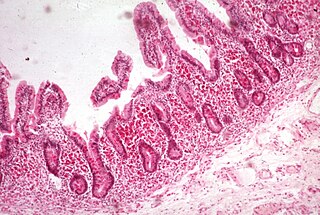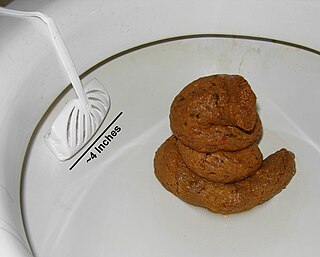Related Research Articles

Crohn's disease is a type of inflammatory bowel disease (IBD) that may affect any segment of the gastrointestinal tract. Symptoms often include abdominal pain, diarrhea, fever, abdominal distension, and weight loss. Complications outside of the gastrointestinal tract may include anemia, skin rashes, arthritis, inflammation of the eye, and fatigue. The skin rashes may be due to infections as well as pyoderma gangrenosum or erythema nodosum. Bowel obstruction may occur as a complication of chronic inflammation, and those with the disease are at greater risk of colon cancer and small bowel cancer.

Ulcerative colitis (UC) is a type of inflammatory bowel disease (IBD). It is a long-term condition that results in inflammation and ulcers of the colon and rectum. The primary symptoms of active disease are abdominal pain and diarrhea mixed with blood (hematochezia). Weight loss, fever, and anemia may also occur. Often, symptoms come on slowly and can range from mild to severe. Symptoms typically occur intermittently with periods of no symptoms between flares. Complications may include abnormal dilation of the colon (megacolon), inflammation of the eye, joints, or liver, and colon cancer.

Irritable bowel syndrome (IBS) is a "disorder of gut-brain interaction" characterized by a group of symptoms that commonly include abdominal pain, abdominal bloating and changes in the consistency of bowel movements. These symptoms may occur over a long time, sometimes for years. IBS can negatively affect quality of life and may result in missed school or work or reduced productivity at work. Disorders such as anxiety, major depression, and chronic fatigue syndrome are common among people with IBS.

Inflammatory bowel disease (IBD) is a group of inflammatory conditions of the colon and small intestine, with Crohn's disease and ulcerative colitis (UC) being the principal types. Crohn's disease affects the small intestine and large intestine, as well as the mouth, esophagus, stomach and the anus, whereas ulcerative colitis primarily affects the colon and the rectum.

Malabsorption is a state arising from abnormality in absorption of food nutrients across the gastrointestinal (GI) tract. Impairment can be of single or multiple nutrients depending on the abnormality. This may lead to malnutrition and a variety of anaemias.
Dysbiosis is characterized by a disruption to the microbiome resulting in an imbalance in the microbiota, changes in their functional composition and metabolic activities, or a shift in their local distribution. For example, a part of the human microbiota such as the skin flora, gut flora, or vaginal flora, can become deranged, with normally dominating species underrepresented and normally outcompeted or contained species increasing to fill the void. Dysbiosis is most commonly reported as a condition in the gastrointestinal tract.

Biological therapy, the use of medications called biopharmaceuticals or biologics that are tailored to specifically target an immune or genetic mediator of disease, plays a major role in the treatment of inflammatory bowel disease. Even for diseases of unknown cause, molecules that are involved in the disease process have been identified, and can be targeted for biological therapy. Many of these molecules, which are mainly cytokines, are directly involved in the immune system. Biological therapy has found a niche in the management of cancer, autoimmune diseases, and diseases of unknown cause that result in symptoms due to immune related mechanisms.
The Crohn's Disease Activity Index or CDAI is a research tool used to quantify the symptoms of patients with Crohn's disease. This is of useful importance in research studies done on medications used to treat Crohn's disease; most major studies on newer medications use the CDAI in order to define response or remission of disease. As Crohn's disease is a disease with a variety of symptoms that affect quality of life, the quantification of symptoms may be of secondary importance to a quantitative assessment of the effect on quality of life. This has been addressed by the Inflammatory Bowel Disease Questionnaire (IBDQ) and other indices of quality of life for patients with Crohn's disease.

Protein losing enteropathy is a syndrome of blood proteins being lost excessively via the gastrointestinal tract. It may be caused by many different underlying diseases that damage the lining of the GI tract (mucosa) or cause blockage of its lymphatic drainage.
Anti-Saccharomyces cerevisiae antibodies (ASCAs) are antibodies against antigens presented by the cell wall of the yeast Saccharomyces cerevisiae. These antibodies are directed against oligomannose sequences α-1,3 Man n. ASCAs and perinuclear antineutrophil cytoplasmic antibodies (pANCAs) are the two most useful and often discriminating biomarkers for colitis. ASCA tends to recognize Crohn's disease more frequently, whereas pANCA tend to recognize ulcerative colitis.

S100 calcium-binding protein A9 (S100A9) also known as migration inhibitory factor-related protein 14 (MRP14) or calgranulin B is a protein that in humans is encoded by the S100A9 gene.

Human feces are the solid or semisolid remains of food that could not be digested or absorbed in the small intestine of humans, but has been further broken down by bacteria in the large intestine. It also contains bacteria and a relatively small amount of metabolic waste products such as bacterially altered bilirubin, and the dead epithelial cells from the lining of the gut. It is discharged through the anus during a process called defecation.
Calprotectin is a complex of the mammalian proteins S100A8 and S100A9. Other names for calprotectin include MRP8-MRP14, calgranulin A and B, cystic fibrosis antigen, L1, 60BB antigen, and 27E10 antigen. The proteins exist as homodimers but preferentially exist as S100A8/A9 heterodimers or heterotetramers (calprotectin) with antimicrobial, proinflammatory and prothrombotic properties. In the presence of calcium, calprotectin is capable of sequestering the transition metals iron, manganese and zinc via chelation. This metal sequestration affords the complex antimicrobial properties. Calprotectin is the only known antimicrobial manganese sequestration protein complex. Calprotectin comprises as much as 60% of the soluble protein content of the cytosol of a neutrophil, and it is secreted by an unknown mechanism during inflammation. Faecal calprotectin has been used to detect intestinal inflammation and can serve as a biomarker for inflammatory bowel diseases. Blood-based calprotectin is used in diagnostics of multiple inflammatory diseases, including autoimmune diseases, like arthritis, and severe infections including sepsis.

Enteropathic arthropathy commonly referred to as enteropathic arthritis, is a type of arthritis linked to Crohn's disease, ulcerative colitis, and chronic inflammatory bowel diseases.
Serum-derived bovine immunoglobulin/protein isolate (SBI) is a medical food product derived from bovine serum obtained from adult cows in the United States. It is sold under the name EnteraGam.
Leukocyte apheresis is a medical device therapy for the treatment of inflammation of the colon. It works by removing from the blood a group of white blood cells called activated leukocytes that play a key role in the inflammatory stages of ulcerative colitis (UC). Selectively reducing these cells in the blood helps to reduce inflammation in the colon. Leukocyte apheresis can help UC patients with chronic, grumbling disease who are either unsuitable for, intolerant of, or failing on medicines described above.

Type 3 innate lymphoid cells (ILC3) are immune cells from the lymphoid lineage that are part of the innate immune system. These cells participate in innate mechanisms on mucous membranes, contributing to tissue homeostasis, host-commensal mutualism and pathogen clearance. They are part of a heterogeneous group of innate lymphoid cells, which is traditionally divided into three subsets based on their expression of master transcription factors as well as secreted effector cytokines - ILC1, ILC2 and ILC3.
Checkpoint inhibitor induced colitis is an inflammatory condition affecting the colon (colitis), which is caused by cancer immunotherapy. Symptoms typically consist of diarrhea, abdominal pain and rectal bleeding. Less commonly, nausea and vomiting may occur, which may suggest the present of gastroenteritis. The severity of diarrhea and colitis are graded based on the frequency of bowel movements and symptoms of colitis, respectively.

Segmental colitis associated with diverticulosis (SCAD) is a condition characterized by localized inflammation in the colon, which spares the rectum and is associated with multiple sac-like protrusions or pouches in the wall of the colon (diverticulosis). Unlike diverticulitis, SCAD involves inflammation of the colon between diverticula, while sparing the diverticular orifices. SCAD may lead to abdominal pain, especially in the left lower quadrant, intermittent rectal bleeding and chronic diarrhea.
Philip Rosenstiel is a German medical doctor and an academic. He is director of the Institute of Clinical Molecular Biology and a professor of clinical molecular biology at Kiel University.
References
- 1 2 3 Brophy MB, Nolan EM (March 2015). "Manganese and microbial pathogenesis: sequestration by the Mammalian immune system and utilization by microorganisms". ACS Chemical Biology. 10 (3): 641–51. doi:10.1021/cb500792b. PMC 4372095 . PMID 25594606.
- ↑ Marshall W, Lapsley M, Day A, Ayling R (2014). Clinical Biochemistry: Metabolic and Clinical Aspects (3rd ed.). Elsevier Health Sciences, 2014. ISBN 9780702054785 . Retrieved 19 January 2015.
- ↑ Gupta, Ramesh (2014). Biomarkers in toxicology. San Diego, CA: Academic Press. pp. 272–273. ISBN 9780124046498 . Retrieved 19 January 2015.
- ↑ Tibble J, Teahon K, Thjodleifsson B, Roseth A, Sigthorsson G, Bridger S, et al. (October 2000). "A simple method for assessing intestinal inflammation in Crohn's disease". Gut. 47 (4): 506–13. doi:10.1136/gut.47.4.506. PMC 1728060 . PMID 10986210.
- 1 2 3 Joshi S, Lewis SJ, Creanor S, Ayling RM (May 2010). "Age-related faecal calprotectin, lactoferrin and tumour M2-PK concentrations in healthy volunteers". Annals of Clinical Biochemistry. 47 (Pt 3): 259–63. doi:10.1258/acb.2009.009061. PMID 19740914. S2CID 5396341.
- 1 2 3 Vaos G, Kostakis ID, Zavras N, Chatzemichael A (2013). "The role of calprotectin in pediatric disease". BioMed Research International (Review). 2013: 542363. doi: 10.1155/2013/542363 . PMC 3794633 . PMID 24175291.
- ↑ Konikoff MR, Denson LA (June 2006). "Role of fecal calprotectin as a biomarker of intestinal inflammation in inflammatory bowel disease". Inflammatory Bowel Diseases (Review). 12 (6): 524–34. doi: 10.1097/00054725-200606000-00013 . PMID 16775498. S2CID 17882721.
- 1 2 Walsham NE, Sherwood RA (2016-01-28). "Fecal calprotectin in inflammatory bowel disease". Clinical and Experimental Gastroenterology. 9: 21–9. doi: 10.2147/CEG.S51902 . PMC 4734737 . PMID 26869808.
- ↑ Stríz I, Trebichavský I (2004-01-01). "Calprotectin - a pleiotropic molecule in acute and chronic inflammation". Physiological Research. 53 (3): 245–53. doi: 10.33549/physiolres.930448 . PMID 15209531. S2CID 19989349.
- ↑ Costa F, Mumolo MG, Bellini M, Romano MR, Ceccarelli L, Arpe P, et al. (September 2003). "Role of faecal calprotectin as non-invasive marker of intestinal inflammation". Digestive and Liver Disease. 35 (9): 642–7. doi:10.1016/s1590-8658(03)00381-5. PMID 14563186.
- 1 2 Waugh N, Cummins E, Royle P, Kandala NB, Shyangdan D, Arasaradnam R, et al. (November 2013). "Faecal calprotectin testing for differentiating amongst inflammatory and non-inflammatory bowel diseases: systematic review and economic evaluation". Health Technology Assessment (Review). 17 (55): xv–xix, 1–211. doi:10.3310/hta17550. PMC 4781415 . PMID 24286461.
- ↑ Zerbato V, Di Bella S, et al. (June 2021). "High fecal calprotectin levels are associated with SARS-CoV-2 intestinal shedding in COVID-19 patients: A proof-of-concept study". World Journal of Gastroenterology. 27 (22): 3130–3137. doi: 10.3748/wjg.v27.i22.3130 . PMC 8192288 . PMID 34168414.
- ↑ Larsson, Geir; Shenoy, Koticherry Thrivikrama; Ramasubramanian, Ramalingom; Thayumanavan, Lakshmikanthan; Balakumaran, Leena Kondarappassery; Bjune, Gunnar A; Moum, Bjørn A (October 2014). "Faecal calprotectin levels differentiate intestinal from pulmonary tuberculosis: An observational study from Southern India". United European Gastroenterology Journal. 2 (5): 397–405. doi:10.1177/2050640614546947. ISSN 2050-6406. PMC 4212497 . PMID 25360318.
- ↑ Gisbert JP, McNicholl AG (January 2009). "Questions and answers on the role of faecal calprotectin as a biological marker in inflammatory bowel disease". Digestive and Liver Disease (Review). 41 (1): 56–66. doi: 10.1016/j.dld.2008.05.008 . PMID 18602356.